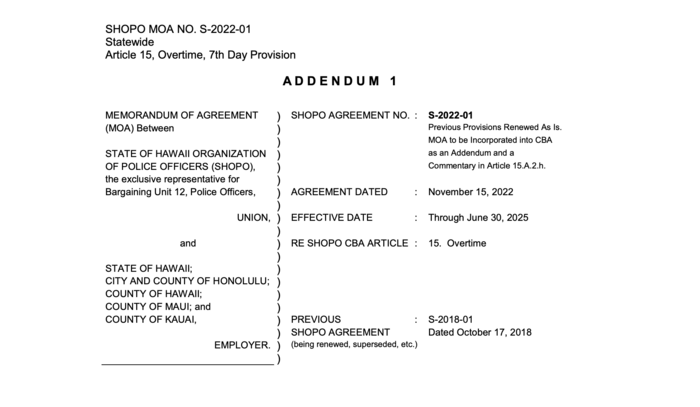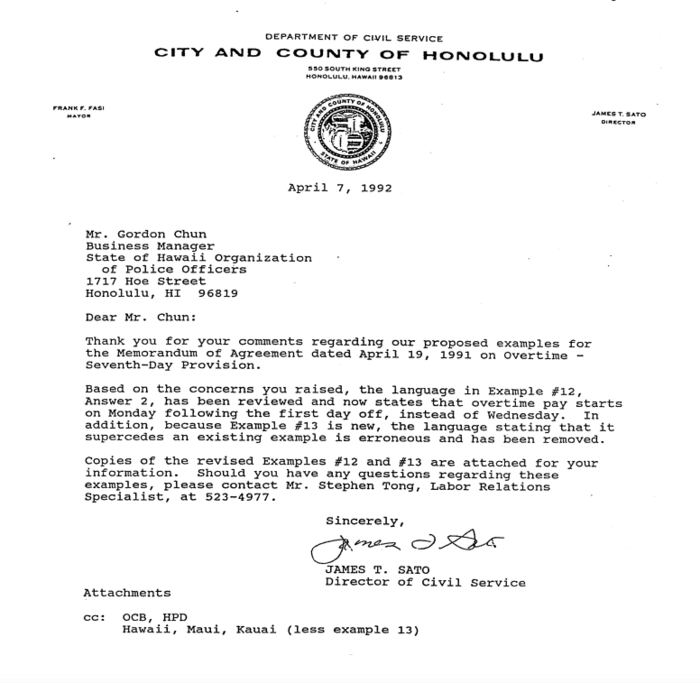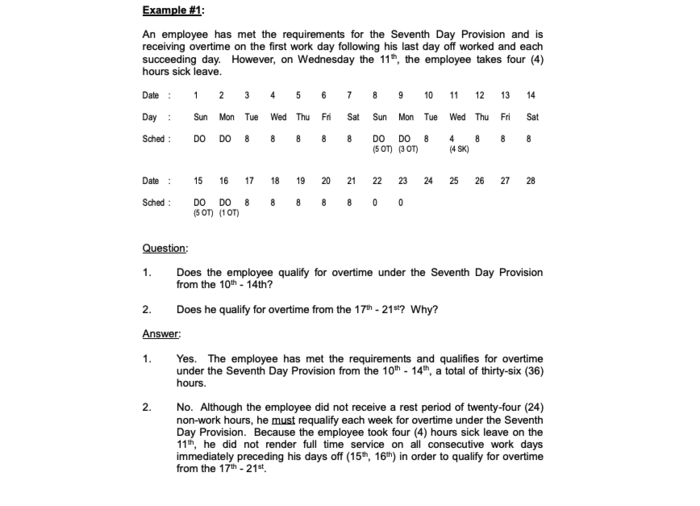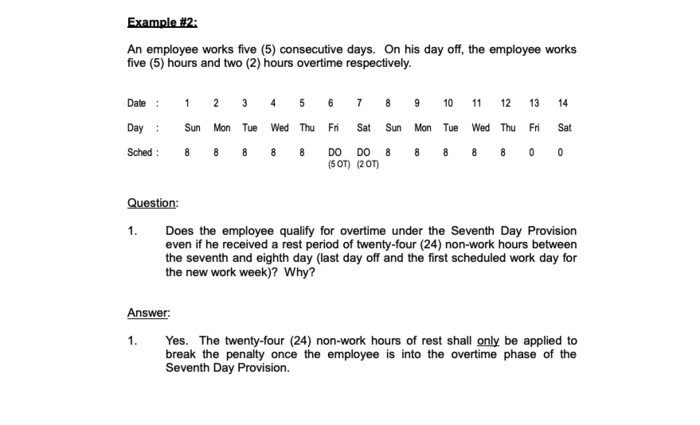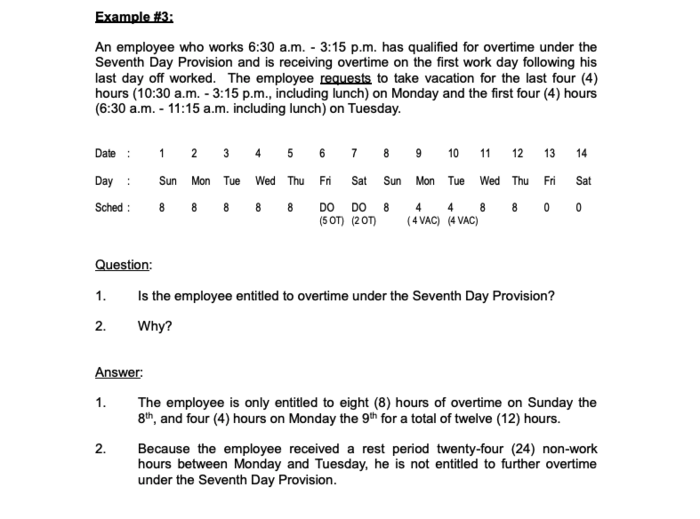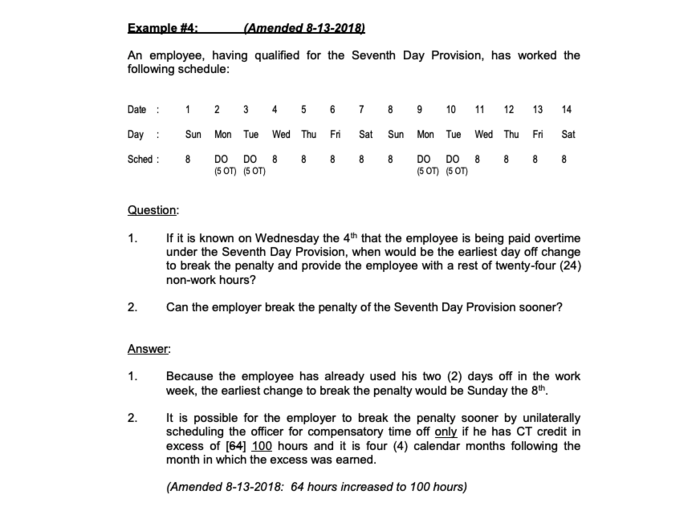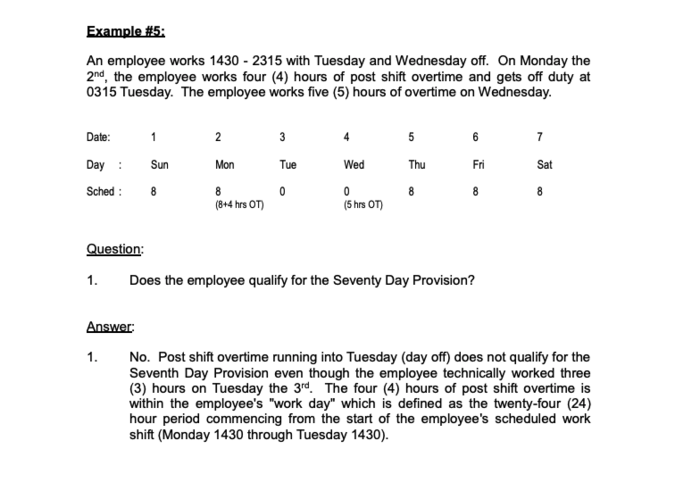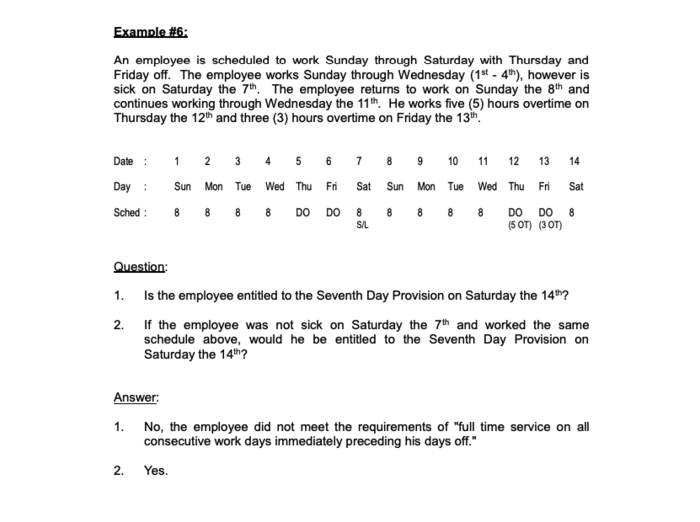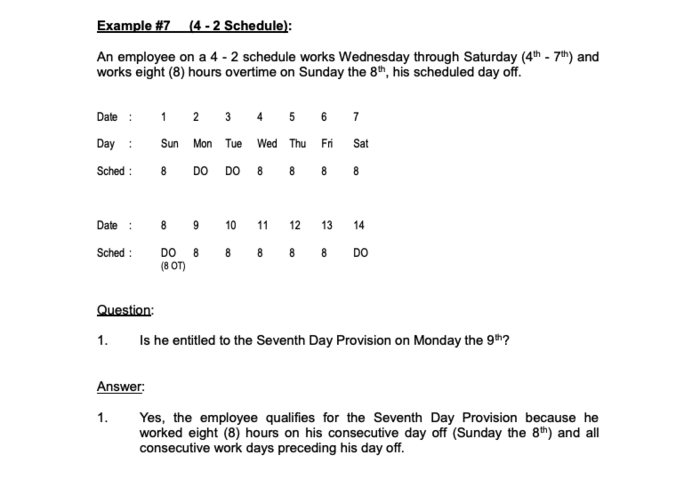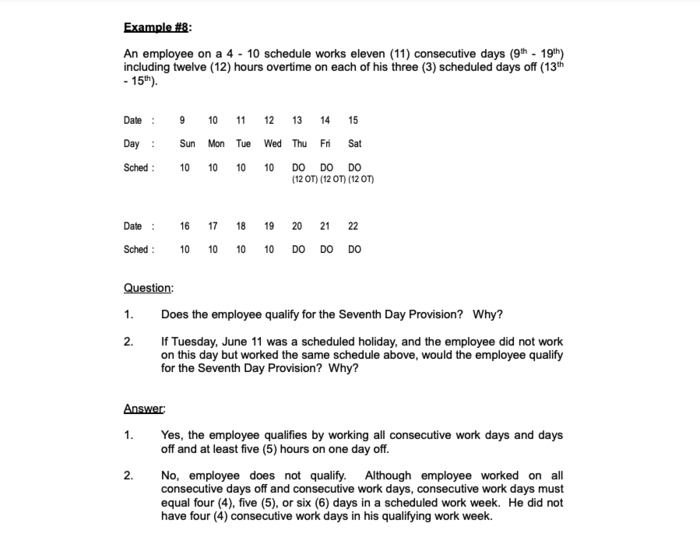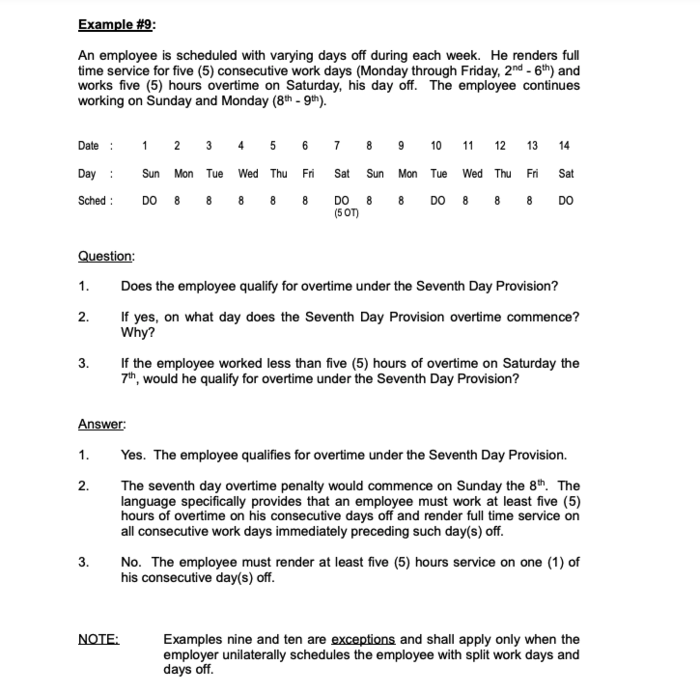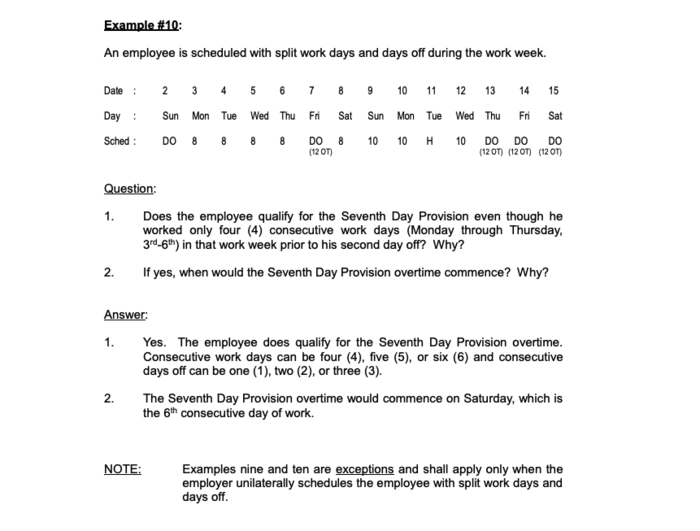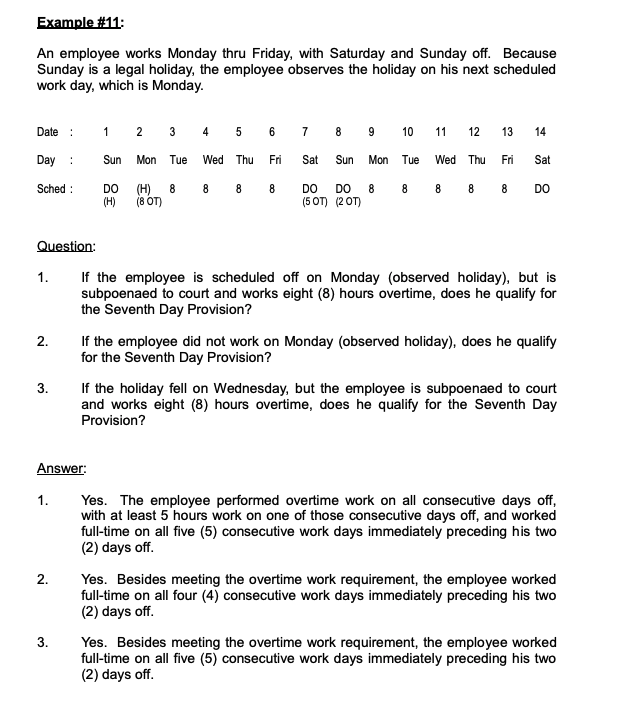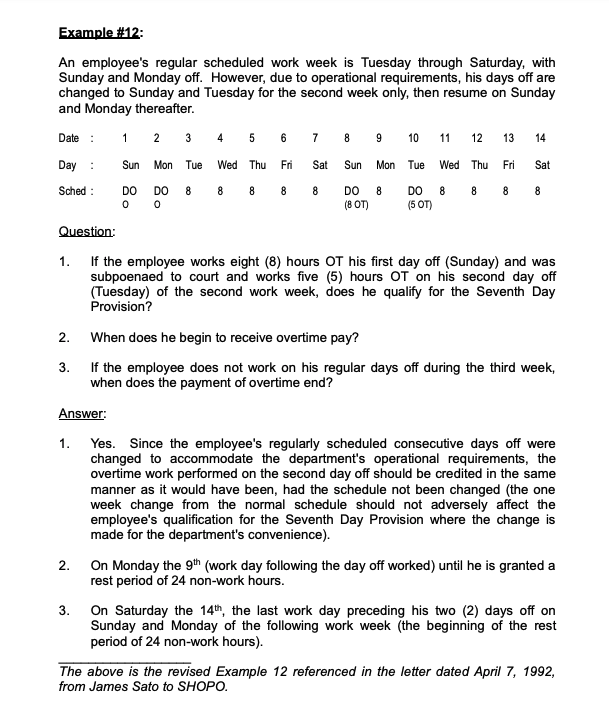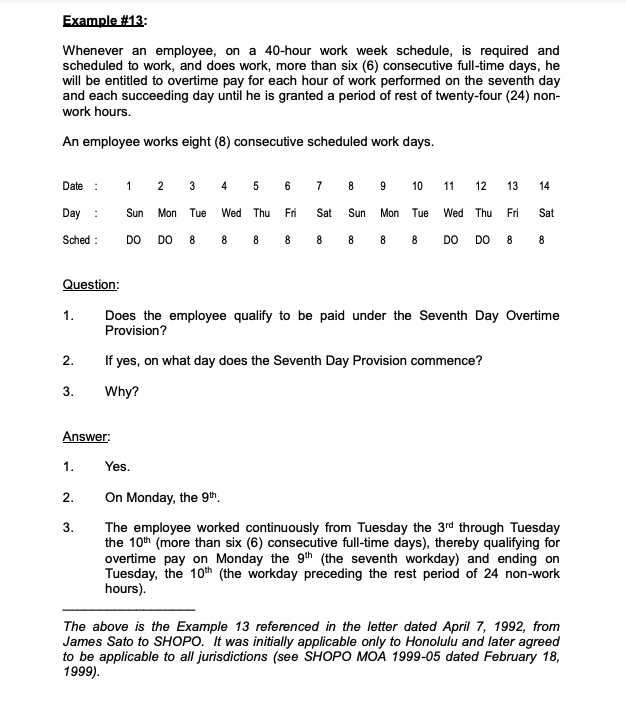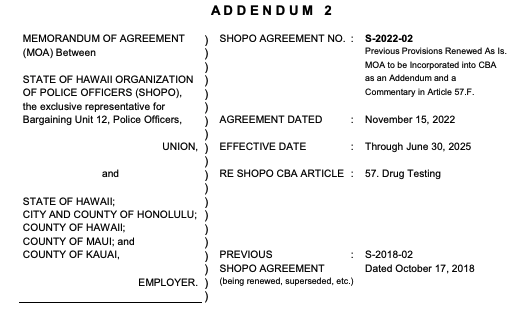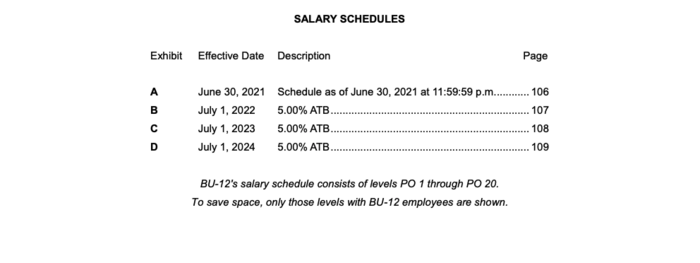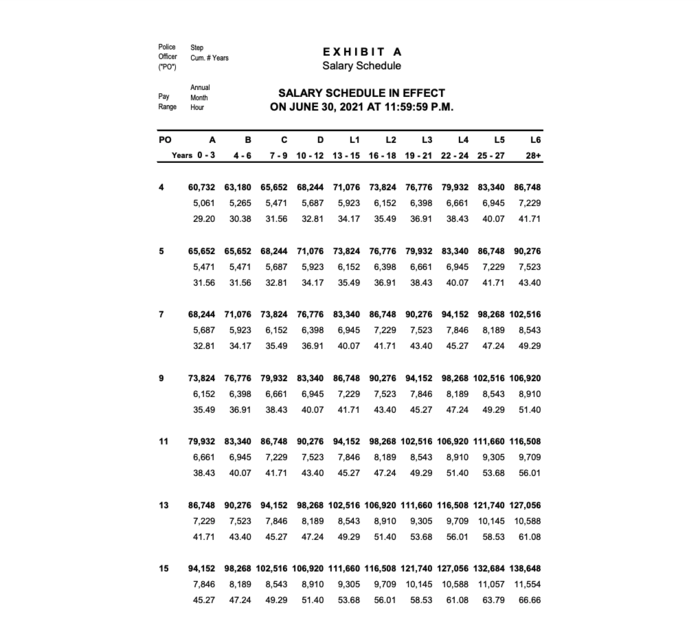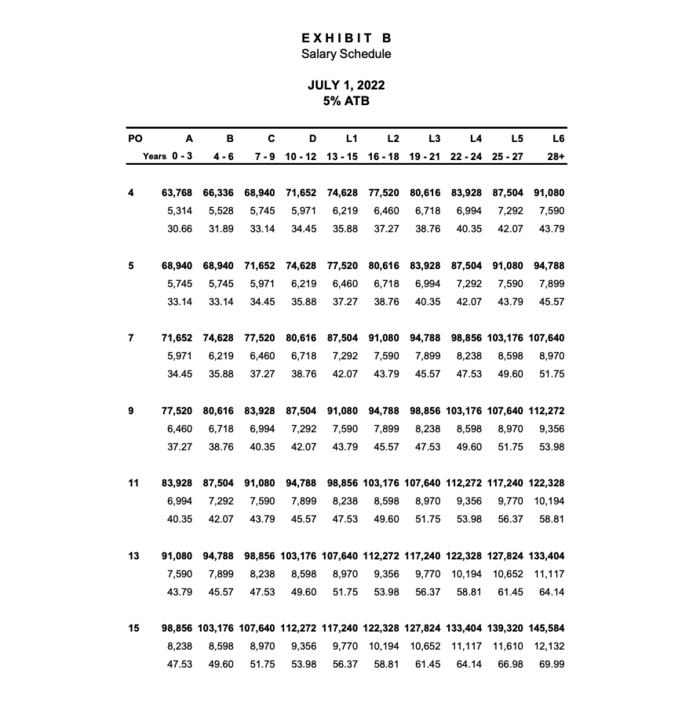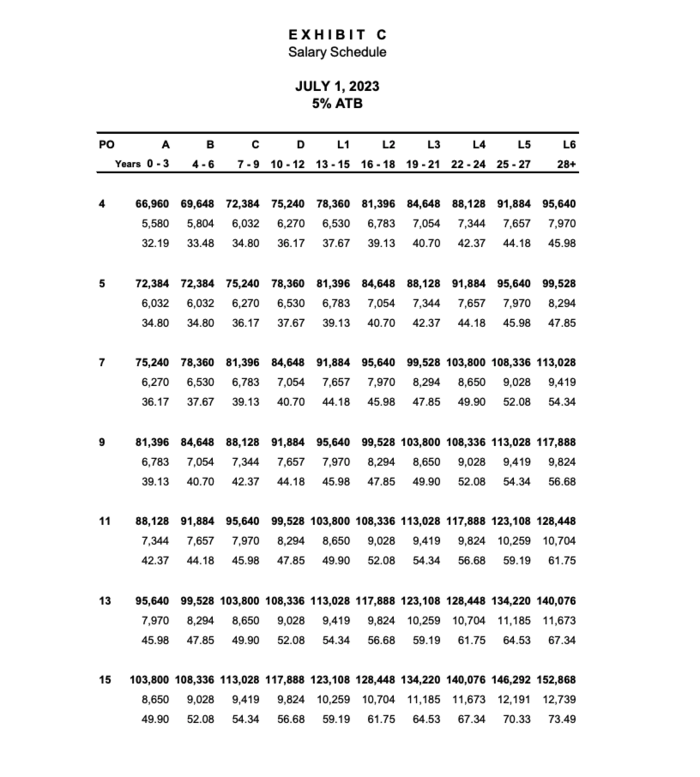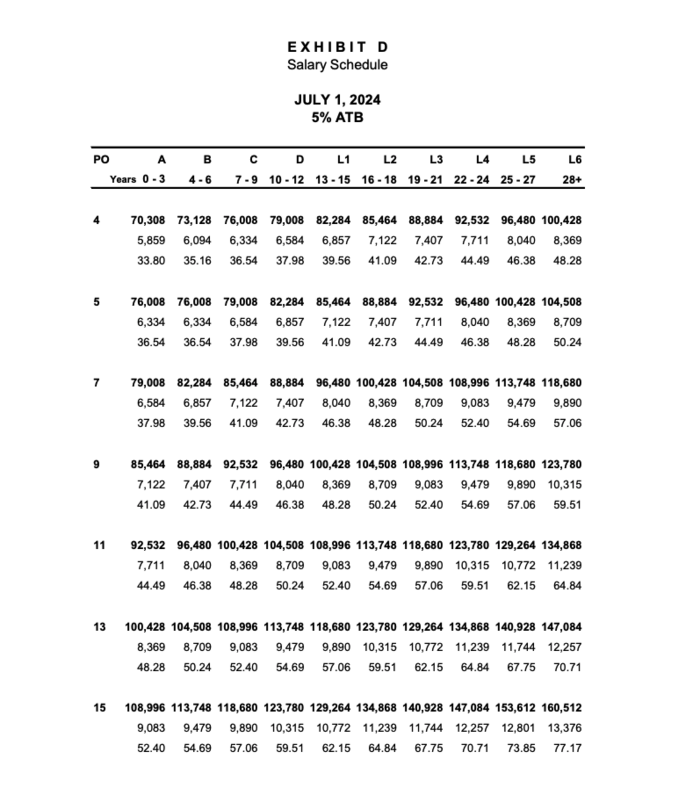| “
|
A. General Provisions - The provisions of this Article shall not be applicable
where an employee moves from one governmental jurisdiction to another, except as
specifically provided herein.
1. Basic Rate of Pay - For purposes of this Article, "basic rate of pay"
means the rate of pay assigned to the salary range and step an employee is
receiving as compensation. For an employee whose rate of pay is not equal to a
step in the salary range, "basic rate of pay" shall mean the actual rate of
compensation the employee is receiving as remuneration for services performed in a
particular position, not including any differentials.
2. Service - For purposes of this Article, "service" shall mean employment
service for the Employer jurisdictions in an existing or former class or position which
is or has been included or excluded from the bargaining unit for which the Union is
certified as the exclusive bargaining representative under the provisions of Chapter
89, Hawaii Revised Statutes, including such service prior to the Union's certification
as exclusive bargaining representative and any non-regular employment service;
provided there is no break in government service and further provided that, effective
July 1, 1989, any move by an employee from one Employer to another Employer
through any procedure other than an intergovernmental movement shall be
considered as a break in service.
3. Order for Making Pay Adjustments - When the effective dates of more
than one personnel action coincide, pay adjustments shall be made in the following
order:
a. Negotiated wage increase, including step movements;
b. Changeover to a new pay schedule;
c. Repricing;
d. Promotion;
e. Reallocation;
f. Other personnel actions.
4. Leaves of Absence Without Pay - A leave of absence without pay shall
end upon the day before the first working day an employee properly reports for duty,
and an employee shall be entitled to receive compensation as of the first working
day the employee properly reports for duty. Each calendar day from the beginning to
the end of an employee's leave of absence without pay shall be charged as leave
without pay provided that an employee who is granted a leave of absence without
pay and who returns to duty after being absent from work for only one working day or
less, shall be charged for one day of leave of absence without pay or less, as
applicable, even though one or more scheduled or normal non-working days or a
holiday may have preceded the employee's return to duty.
5. Pay Adjustments / Less Than a Normal Month - Pay adjustments for
employees who work less than a normal month shall be computed pursuant to the
following formula: Employee's monthly basic rate of pay plus Temporary Differential
(TD) or Temporary Step Differential (TSD) as applicable multiplied by (number of
days worked divided by number of working days in a month, including holidays).
6. Personal Injury - An employee who suffers a disabling personal injury
arising out of and in the course of employment, except for an injury caused by the
employee's negligence, willful intention to injure the employee or others, or by the
employee's intoxication or because of the influence of a non-prescribed controlled
substance, shall be credited for a full day's work on the day of the injury regardless
of the time the employee is injured.
7. Overpayment - An employee who initially was properly compensated
following a promotion, the adoption of a new pay schedule, a temporary assignment,
pricing or repricing, or any other personnel action affecting pay, shall not be required
to make reimbursement when it is found subsequently that an overpayment in salary
occurred due to the retroactive feature of a position classification action. However,
the proper pay adjustment shall be made as of the first pay period following the date
of notice of action by the director.
B. Compensation Adjustment Upon Promotion - As used in this paragraph,
"promotion" means the movement of a regular employee from the position in which
the employee last held a permanent appointment to a vacant civil service position
assigned to a class with a higher pay range in the salary schedule.
1. Compensation - A regular employee who is promoted shall be
compensated at the step in the higher salary range which corresponds to the
employee's cumulative years of service in paragraph K.2, provided that:
- a. If the employee's step in the lower pay range is lower than warranted by the employee's cumulative years of service, the employee shall be compensated at the step in the higher pay range which corresponds to the employee's step in the lower pay range.
- b. If the employee's step or basic rate of pay in the lower pay range is higher than warranted by the employee's cumulative years of service, the employee shall be compensated at the step in the higher pay range which corresponds to the employee's cumulative years of service. In the event, the employee's basic rate of pay is greater than such step in the higher pay range, the employee shall be entitled to a temporary step differential.
- c. If the employee's basic rate of pay falls between two steps in the lower pay range, the employee shall be compensated at the step in the higher pay range which corresponds to the step in the lower pay range whose rate is immediately above the employee's basic rate of pay. If there is no step in the higher pay range which rate exceeds the employee's basic rate of pay, the employee shall be compensated at the maximum step in the higher pay range, or at the employee's basic rate of pay, whichever is greater.
2. Promotion Within 12 Months of Demotion - The compensation of an
employee who is promoted within twelve months from the effective date of a
demotion, other than a disciplinary or involuntary demotion, shall be adjusted from
the rate the employee would have received had the demotion not occurred.
3. Return to Permanent Appointment Following Limited Term
Promotion - A regular employee who returns to the position which the employee last
held a permanent appointment after a limited term promotion shall be compensated
as though the employee had remained in the former position continuously.
C. Compensation Adjustment Upon Demotion
1. Definitions - The following definitions shall be applicable to this
paragraph:
- a. "Demotion" means the movement of a regular employee from the position in which the employee last held a permanent appointment to a vacant civil service position assigned to a class with a lower pay range in the salary schedule.
- b. "Demotion due to a reorganization" means a demotion of an employee as a result of a reorganization action.
- c. "Demotion to avoid layoff" means a demotion accepted by an employee to avoid being laid off.
- d. "Disciplinary demotion" means a demotion action taken by the appointing authority for disciplinary reasons.
- e. "Involuntary demotion" means a demotion action taken by the appointing authority due to the employee's inability to perform the duties and responsibilities of the employee's position, or due to the employee's failure to meet qualification requirements for the position.
- f. "Non-service connected disability demotion" means the movement of an employee to a vacant civil service position assigned to a class with a lower pay range in the salary schedule, due to a disability sustained by the employee other than while performing the duties and responsibilities of the employee's position.
- g. "Service connected disability demotion" means the movement of a regular employee or an employee serving an initial probationary period to a vacant civil service position assigned to a class with a lower pay range in the salary schedule, due to a disability sustained by the employee while performing the duties and responsibilities of the employee's position.
- h. "Voluntary demotion" means a demotion requested by an employee and granted by the appointing authority.
2. Disciplinary or Involuntary Demotion
- a. A regular employee who is involuntarily demoted or who is demoted for disciplinary reasons shall be compensated at the step in the lower salary range which corresponds to the employee's cumulative years of service, provided that if the employee's step in the higher pay range is lower than warranted by the employee's cumulative years of service, the employee shall be compensated at the step in the lower pay range which corresponds to the employee's step in the higher pay range.
- b. Upon release from a disciplinary demotion given on a temporary basis, a regular employee shall be compensated as though the employee had remained in the former position continuously.
3. Demotion to Avoid Layoff; Demotion Due to Reorganization; Service
Connected Disability Demotion - An employee who accepts a demotion to avoid a
layoff; or who demoted due to a reorganization; or who receives a service connected
disability demotion, shall be compensated at the step in the lower pay range which
corresponds to the employee's cumulative years of service and shall be entitled to a
temporary step differential as provided in paragraph J; provided that: if the
employee's basic rate of pay falls above the maximum step in the lower pay range,
the employee shall be additionally entitled to a temporary differential. The temporary
differential and temporary step differential shall be computed as follows: The amount
of the TD shall be the difference between the employee's existing basic rate of pay
and the rate of the maximum step of the lower pay range. The amount of the TSD
shall be the difference between the rate of the maximum step of the lower pay range
and the rate of the step in the lower pay range which corresponds to the employee's
cumulative years of service.
4. Non-Service Connected Disability Demotion - An employee who
receives a non-service connected disability demotion shall be compensated as
provided below:
- a. A regular employee who has fifteen or more years of service shall be compensated at the step in the lower pay range which corresponds to the employee's cumulative years of service and shall be entitled to a temporary step differential as provided in the paragraph J; provided that: if the employee's basic rate of pay falls above the maximum step in the lower pay range, the employee shall be additionally entitled to a temporary differential. The temporary differential and temporary step differential shall be computed as in subparagraph 3 above.
- b. A regular employee with at least five years but less than fifteen years of service shall be compensated at the step in the lower pay range which corresponds to the employee's cumulative years of service and shall be entitled to a temporary step differential as provided in paragraph J; provided that if the employee's basic rate of pay falls above the maximum step in the lower pay range, the employee shall be additionally entitled to a temporary differential for a period beyond the effective date of the demotion as follows:
[SEE NOTE 1 AT END OF SECTION FOR FULL TABLE]
If both temporary differential and temporary step differential are applied,
they shall be computed as in subparagraph 3 above.
- c. The basic rate of pay of a regular employee with less than five years of service, or a regular employee whose retention period as prescribed in subparagraph 4.b, has expired, shall be adjusted in the manner of adjustments for service connected disability demotion, provided the employee shall not be entitled to a temporary differential.
5. Voluntary Demotion
- a. A regular employee who accepts a voluntary demotion shall be compensated at the step in the lower pay range which corresponds to the employee's step in the higher pay range, provided that if the employee's basic rate of pay falls above the maximum step in the higher pay range, the employee shall be compensated at the maximum step in the lower pay range.
- b. Upon return to the position in which an employee last held a permanent appointment, a regular employee who is demoted on a temporary or provisional appointment basis shall be compensated as though the employee had remained in the former position continuously.
D. Compensation Adjustment Upon Transfer - "Transfer" means the movement
of a regular employee from the position in which the employee last held a permanent
appointment to a vacant civil service position which is in the same class or in a
different class assigned to the same pay range in the salary schedule. A regular
employee who is transferred shall continue at the same basic rate of pay.
E. Compensation Adjustment Upon Reallocation
1. Definitions - The following definitions shall be applicable to this
paragraph:
- a. "Reallocation Downward" means the reallocation of a position to a class assigned to a lower pay range in the salary schedule.
- b. "Reallocation Upward" means the reallocation of a position to a class assigned to a higher pay range in the salary schedule.
2. Compensation: Reallocation Upwards - Compensation following
reallocation upwards shall be adjusted in the manner as adjustments for promotion.
3. Compensation: Reallocation Downwards - Compensation adjustment
for a reallocation downwards shall be in the manner prescribed in paragraph C.3.
However, when downward reallocations are due to disciplinary, involuntary, or
voluntary reasons, the employee's basic rate of pay shall be adjusted in the manner
as adjustments for disciplinary, involuntary, or voluntary demotions, as applicable.
4. Compensation: Class / Same Pay Range - Compensation following
reallocation of a position in a class to the same pay range shall be adjusted in the
manner of adjustments for transfer.
F. Compensation Adjustment Upon Repricing
1. Class in a Higher Pay Range - The basic rate of pay of an employee
whose position is in a class which is repriced to a higher pay range shall be adjusted
in the manner as adjustments for promotion.
2. Class in a Lower Pay Range - The basic rate of pay of an employee
whose position is in a class which is repriced to a lower pay range shall be adjusted
in the manner as adjustments are prescribed in paragraph C.3.
G. Compensation of New Employees Entering the Bargaining Unit -
Notwithstanding any paragraph in this Article, new employees entering the
bargaining unit shall be compensated in accordance with applicable civil service
rules or law, provided that any employee whose salary exceeds the employee's
appropriate step based on the employee's cumulative years of service shall be
placed at the appropriate step and shall be entitled to a temporary step differential.
H. Compensation for Temporary Assignment Performed
1. Compensation - Compensation for temporary assignment shall be as
follows:
- a. Except as provided in subparagraph 3, the basic rate of pay of an employee who performs temporary assignment involving a position assigned to a class in a higher pay range in the salary schedule shall be adjusted in the manner as adjustments for promotion except that any temporary differential which the employee was receiving shall not be added to the basic rate of pay but shall be retained by the employee while performing the temporary assignment. Any employee who performs temporary assignment involving a position for which an adjusted entry rate has been prescribed by the Employer, and whose rate of pay, when adjusted hereunder is below the adjusted entry rate, shall be entitled to an additional amount of compensation which shall be the difference between the employee's adjusted rate of pay and the adjusted entry rate prescribed by the Employer. This difference, to be referred to as a temporary assignment differential (TAD), shall not be considered as part of the employee's basic base pay. The TAD shall end upon completion of the temporary assignment.
- b. An employee who performs a temporary assignment involving a position assigned to the same or lower pay range in the salary schedule shall continue to be compensated at the employee's basic rate of pay prior to the temporary assignment. It is provided that any employee who performs temporary assignment involving a position for which an adjusted entry rate has been prescribed by the Employer, and whose basic rate of pay is below the adjusted entry rate, shall be entitled to an additional amount of compensation which shall be the difference between the employee's basic rate of pay and the adjusted entry rate prescribed by the Employer. The difference, to be referred to as a temporary assignment differential (TAD), shall not be considered as part of the employee's base pay. The TAD shall end upon completion of the temporary assignment.
- c. Whenever a temporary assignment involves the assumption of the duties and responsibilities of a position in the Excluded Managerial Compensation Plan (EMCP), such assignment shall be compensated as though the temporary assignment had occurred within the same salary schedule. (To determine the adjustment, use the following equivalency table: EM 01 equates to SR 24, EM 02 equates to SR 25, EM 03 equates to SR 26, etc.)
2. Exceptions - The following employees shall not be entitled to temporary
assignment compensation:
- a. An employee who is performing duties in accordance with the terms of a formal training agreement entered into with the employee's department and approved by the director.
- b. An employee who is performing a normal relief assignment which is recognized in the employee's position classification and pricing.
I. Temporary Differential Pay
1. Calculation of Temporary Differential Pay - An employee shall be
eligible for temporary differential pay as may be provided in this Article. The amount
of TD pay shall be the difference between the employee's basic rate of pay prior to
the particular action taken and the employee's new basic rate of pay.
2. Temporary Differential Not Considered as Part of Base Pay - The TD
pay shall not be considered part of an employee's basic rate of pay.
3. Reductions Following Promotion, Upward Reallocation or Repricing
Upwards - The TD pay shall be reduced by an amount equal to any adjustment in
the employee's basic rate of pay due to promotion, upward reallocation, or repricing
upward actions. When the adjustment due to these actions is greater than or equal
to the TD pay, the TD pay shall be terminated.
4. Continuation of Temporary Differential Following Demotion, Transfer
or Reallocation to a Class in the Same or Lower Pay Range - When an employee
with TD pay is demoted or transferred, or whose position is reallocated to a class in
the same or lower pay range, the TD shall be continued in the new pay range.
J. Temporary Step Differential
1. Calculation of Temporary Step Differential Pay - An employee shall be
eligible for temporary step differential pay (TSD) as may be provided in this Article.
The amount of the TSD pay shall be the difference between the employee's basic
rate of pay prior to the particular action taken and the employee's new basic rate of
pay.
2. Temporary Step Differential Not Considered as Part of Base Pay -
The TSD shall not be considered part of an employee's basic rate of pay.
3. Reductions in Temporary Step Differential Following Step Movement,
Promotion, Upward Reallocation or Repricing Upwards - The TSD pay shall be
reduced by an amount equal to any adjustment in the employee's basic rate of pay
due to step movement, promotion, upward reallocation or repricing upward actions.
When the adjustment due to these actions is greater than or equal to the TSD pay,
the TSD pay shall be terminated.
4. Continuation of Temporary Step Differential Following Demotion,
Transfer or Reallocation to a Class in the Same or Lower Pay Range - When an
employee with TSD pay is demoted or transferred, or whose position is reallocated to
a class in the same or lower pay range, the TSD shall be continued in the new pay
range.
K. Step Movements
1. Definitions - The following definitions shall be applicable to this
paragraph:
- a. "Step movement" means an increase from an employee's basic rate of pay to the next higher step within the pay range which may be granted as provided in Article 30, Salaries.
- b. "Police service anniversary date" means the date the employee is granted a step movement, which may be the anniversary of the date the employee
was initially appointed or moved into a full-time position as a uniformed member of the Police Departments of the Employer jurisdictions.
2. Eligibility for Step Movement - Any employee at a step or rate below the
maximum step of the pay range shall be eligible for and shall receive a step
movement on the employee's police service anniversary date, provided the
employee has completed the cumulative years of service corresponding to the next
higher step as specified in the following:
[SEE NOTE 2 AT END OF SECTION FOR FULL TABLE]
Effective June 30, 2021 at 11:59:59 p.m.:
[SEE NOTE 3 AT END OF SECTION FOR FULL TABLE]
3. Creditable Service for Step Movements
- a. Service throughout a work year shall be creditable for a step movement provided that:
- 1) absences without pay, except as provided in subparagraph 3.b. below; or
- 2) absences due to suspensions shall be considered time not creditable and shall be made up by rendering a period of service equal to the time not creditable.
- b. A period of authorized leave without pay for the following purposes shall be construed as creditable service:
- 1) to pursue a course of instruction, relating to the employee's work,
- 2) to engage in research, relating to the employee's work,
- 3) to render services at the State legislature,
- 4) to serve on loan by contract to another government,
- 5) to be on sabbatical leave,
- 6) to be on military service,
- 7) to recuperate from an injury for which workers' compensation weekly payments are made, or
- 8) to work in an exempt position.
4. Recognition of Experienced Journey Level Officer - In recognition of
the journey level police officer with thirteen or more years of experience, effective
July 1, 1990, there shall be a two step interval between steps D and L1 of the PO 7
salary range.
L. Compensation Adjustments Following an Intergovernmental Movement
Made Pursuant To Law - When an intergovernmental movement has been made
pursuant to law, the compensation of the regular employee involved shall be
adjusted as follows:
1. Class in a Higher Pay Range - If the result of the intergovernmental
movement is that the employee moves to a position assigned to a class with a higher
pay range in the salary schedule than the previous pay range, the employee's
compensation shall be adjusted in the manner as adjustments for promotion.
2. Class in the Same Pay Range - If the result of the intergovernmental
movement is that the employee moves to a position assigned to a class with the
same pay range in the salary schedule as the previous pay range, the employee's
compensation shall be adjusted in the manner of adjustments for transfer.
3. Class in a Lower Pay Range - If the result of the intergovernmental
movement is that the employee moves to a position assigned to a class with a lower
pay range in the salary schedule than the previous pay range, the employee's
compensation shall be adjusted in the manner as adjustments for voluntary
demotion.
M. Other Compensation Adjustments - Compensation adjustments not
expressly provided for by this Article but necessitated by authorized personnel
movements or situations shall be made by the director of personnel services, director
of civil service, or the administrative director of the courts, as applicable; provided
that consultation shall take place with the Union prior to effecting any adjustments
under this paragraph.[2]
|
”
|



